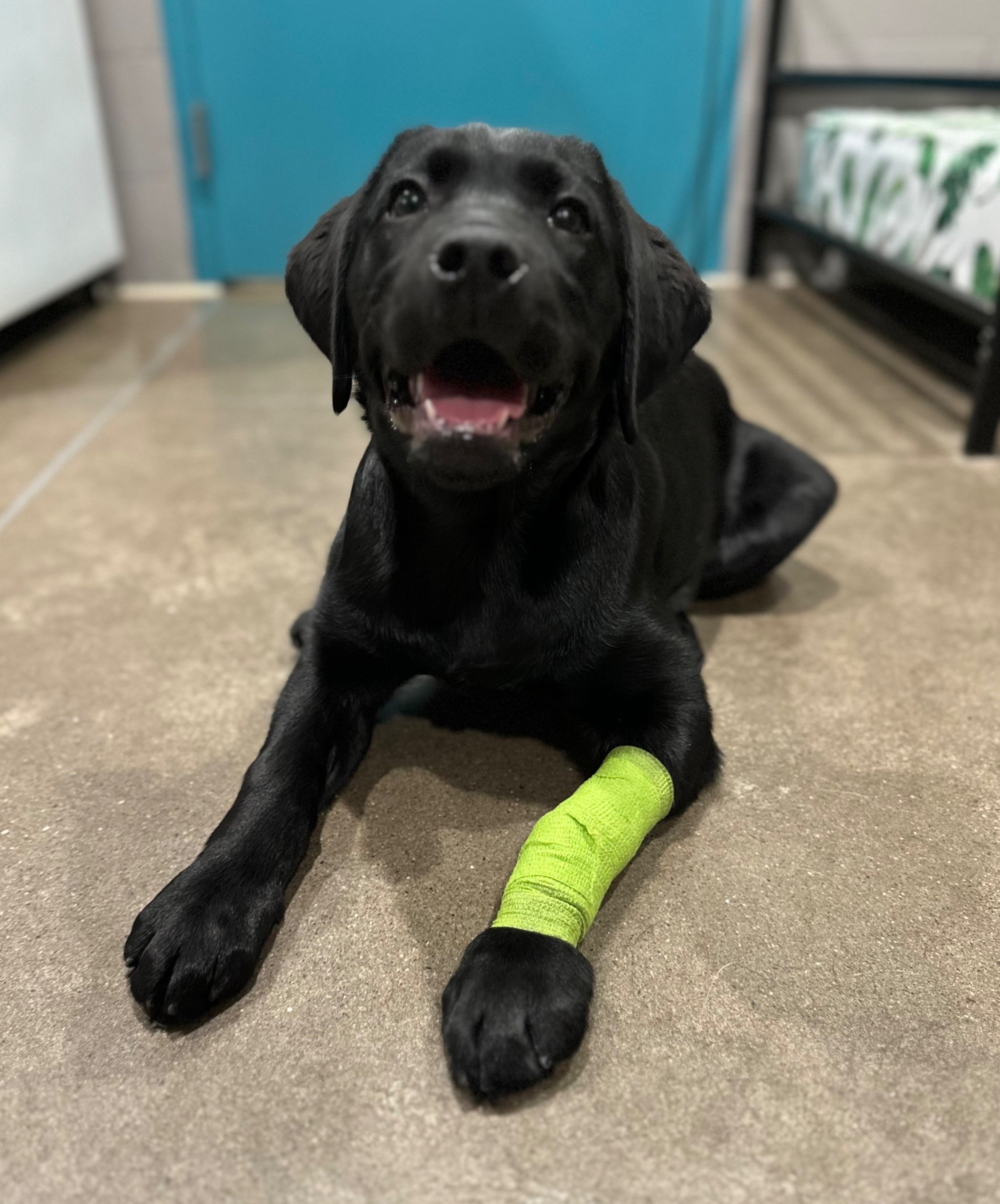National Pet First Aid Awareness Month: Be Prepared to Help Your Pet in an Emergency
April is National Pet First Aid Awareness Month, a time dedicated to raising awareness about pet safety and ensuring pet parents are equipped with the necessary skills to handle health emergencies.
Just like humans, pets can face unexpected accidents, illnesses, or injuries—and being equipped with the knowledge and tools to respond quickly can make all the difference!
Whether you’re a first-time pet parent or a seasoned pro, knowing basic first aid can make a crucial difference in an emergency situation. Whether it’s a cut, a burn, or an allergic reaction, knowing how to react can reduce panic, prevent further injury, and possibly even save a life.
While a vet’s office or emergency animal hospital is always the best place to go for serious conditions, first aid knowledge can help stabilize your pet before you get there. That’s why this month’s blog is all about raising awareness to ensure that we’re all prepared to care for our furry companions when they need us the most.
Because Dog Star Ranch is a canine care facility, we’re going to focus the rest of this blog post on canine care. However, please note that while we aim to provide helpful information, we are not veterinarians, and this content is not intended to offer medical advice. Instead, we aim to provide general suggestions based on common knowledge. For any medical concerns or questions about your pet’s health, always consult with a licensed veterinarian, as they are the best resource for personalized care.
Common Pet Emergencies
Every pet owner should be aware of the most common emergencies that can arise, so that you’re ready when it counts. Here are some common dog injuries and how to respond:
Swallowed Objects
Dogs are known for their curiosity, and sometimes that means swallowing things they shouldn’t like rocks, socks, coins, etc. While some objects may pass naturally, others can cause choking or a dangerous intestinal blockage. Signs include gagging, pawing at the mouth, or difficulty breathing. If your dog is choking, you may need to perform the Heimlich maneuver or gently remove the object if possible. If you suspect an obstruction, contact your vet immediately.
Poisoning
Dogs often ingest things they shouldn’t, from chocolate and plants to household cleaners and medications. Symptoms of poisoning may include vomiting, diarrhea, drooling, or unusual behavior. Contact your vet immediately if you suspect poisoning and bring the item or substance with you if possible.
Eye Injuries
Eye injuries are common in active dogs, especially those that run through brush or play roughly. Symptoms include squinting, excessive tearing, discharge, redness, or swelling. If you notice these signs, avoid touching the eye and contact your vet for a treatment plan.
Broken or Torn Nails
Dogs can catch their nails on fabrics, rough surfaces, or crates, causing painful breaks or tears. To prevent this, keep their nails trimmed—about every 2 to 3 weeks is a good rule of thumb. If a nail is torn, apply gentle pressure to stop the bleeding and consult your vet if necessary.
Bite Wounds
Bite wounds from other animals can introduce bacteria and lead to serious infections. If your dog is bitten, clean the wound with mild antiseptic and seek veterinary care, especially if the bite is deep or bleeding heavily.
Fractured Teeth
Chewing on hard objects like bones, antlers, or rocks can cause fractured teeth. Signs include difficulty eating, blood in the saliva, or swelling around the mouth. If you suspect a tooth fracture, see your vet as soon as possible.
Lacerations, Cuts, and Scratches
Dogs can suffer cuts from sharp objects like glass, metal, or rough terrain. Clean minor wounds with saline solution and apply antibiotic ointment. Deeper cuts may require stitches or antibiotics—when in doubt, contact your vet.
Tail Injury
Certain breeds, especially large dogs, can experience “happy tail,” where excessive wagging against hard surfaces causes bruising or abrasions. Another issue, “limber tail syndrome,” results in a limp, painful tail often caused by overuse, such as prolonged swimming (which is why it’s also referred to as “swimmer’s tail”). Rest and monitoring are key, but severe cases may need veterinary attention.
Seizures
A dog having a seizure will lose control of their body and may shake or convulse. Move any dangerous objects away from your dog to prevent injury and make sure they have plenty of space to move around (avoid holding them down and allow them to move freely). Note the duration of the seizure. If it lasts longer than 5 minutes or if they have multiple seizures in a row, seek immediate veterinary care. Along with keeping track of the duration, also make note of any other symptoms and triggers, this information can be helpful when speaking to your veterinarian.
Heatstroke
Dogs, especially those with thick coats, are highly susceptible to overheating in hot weather. Watch for symptoms such as excessive panting, drooling, confusion, vomiting, diarrhea, uncoordinated movements, and, in severe cases, collapse or seizures. If you suspect heatstroke, immediately move your dog to a shaded or air-conditioned area to help lower their body temperature. Use cool (not cold) water to wet their body, focusing on key areas like the belly, paws, and underarms. You can do this by placing a damp towel over them or gently rubbing their paws with a cool, wet cloth. If you have a thermometer, check your dog’s temperature. If your dog’s temperature exceeds 104°F, it’s a medical emergency. Heatstroke can be fatal if not treated promptly. Even if your dog appears to recover, take them to the vet immediately for a thorough evaluation.
Hypothermia
Hypothermia occurs when a dog’s body temperature drops dangerously low. Symptoms include shivering, lethargy, weakness, shallow breathing, slow heart rate, pale or blue gums, and, in severe cases, collapse or unconsciousness. If you suspect hypothermia, bring your dog indoors immediately. Gradually warm them using blankets, towels, or warm (not hot) water bottles. Focus on warming key areas like the chest and belly by placing warm items around their body. Wrap your dog in thick towels or blankets for added insulation. If your dog is conscious and able to drink, offer small amounts of lukewarm water. Do not use hot water, direct heat, or heating pads, as rapid warming can cause shock or burns. Warmth should be applied gradually. If you have a thermometer, check their temperature. If your dog’s temperature is below 98°F, it’s a medical emergency. Even if your dog seems to improve, contact our vet as soon as possible—hypothermia can lead to serious complications, including organ failure, and may require medical intervention for full recovery.
Be Ready
Emergencies can happen at any time, and having the right knowledge can save your dog’s life. This National Pet First Aid Awareness Month, take the time to prepare, create (or re-stock) your dog’s first aid kit, and consider enrolling in a first aid training course.
Here are some essential first aid skills that every pet parent should learn:
CPR for Dogs: If your dog is unresponsive and not breathing, you can perform CPR by gently tilting their head back to open their airway, performing chest compressions with your hands, and giving rescue breaths.
Bandaging Wounds: For cuts or scrapes, it’s important to clean the wound with antiseptic and then bandage it. Make sure the bandage is snug but not too tight, and monitor the area for any signs of infection.
Dealing with Poisoning: If your dog ingests something toxic, you may need to induce vomiting. Never do this without first consulting a vet or animal poison control, as some substances can cause more harm if vomited up.
Did you know you can take a pet first aid course? One of the best ways to prepare for emergencies is to be educated in pet first aid. There are many online and in-person classes available, often taught by veterinarians or trained professionals. You can also find tutorials, instructional videos, and pet first aid manuals to help you become more comfortable with emergency care. The Red Cross offers an online Cat and Dog First Aid training course at redcross.org, covering:
How to check your dog’s vital signs
Preventative care strategies
Recognizing and responding to emergencies
Additionally, the Red Cross Pet First Aid App is a great mobile resource with step-by-step guidance for common pet emergencies.
Taking the time to learn these essential skills can give you confidence in stressful situations, allowing you to stay calm and focused when your dog needs you most.
Building a First Aid Kit
You can always build your own first aid kit using this comprehensive First Aid Checklist, or there are plenty of pre-made kits available that come with the basic essentials. If you go the pre-made route, be sure to check for key items like hydrogen peroxide, a thermometer, and wound care supplies, as some kits may need a few additions to be fully stocked.
Make sure to store your kit in a easily accessible location and check it regularly for expired items.
Preventing Emergencies Before They Happen
While it’s important to know what to do during an emergency, it’s equally important to prevent accidents before they occur. Here are some tips to help keep your furry family member safe:
Keep harmful chemicals, sharp objects, and choking hazards out of reach
Keep human foods and toxic plants away from your pets. Learn which foods are dangerous and create a safe feeding routine
Always supervise your dog when they are playing outside, especially in areas with traffic, water, or wildlife
Resources
To learn more about pet first aid, consider these resources:
American Red Cross Pet First Aid Course
Pet First Aid & CPR from the American Veterinary Medical Association
As we celebrate National Pet First Aid Awareness Month, take a moment to think about how prepared you are for a pet emergency. Share this information with fellow pet parents and encourage them to get trained, create a pet first aid kit, and take steps to prevent accidents. The more you know, the safer your pups will be!



